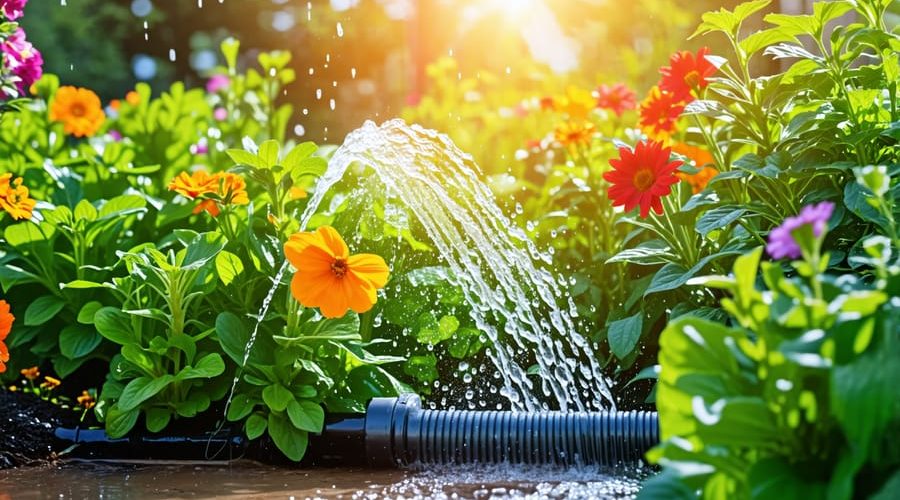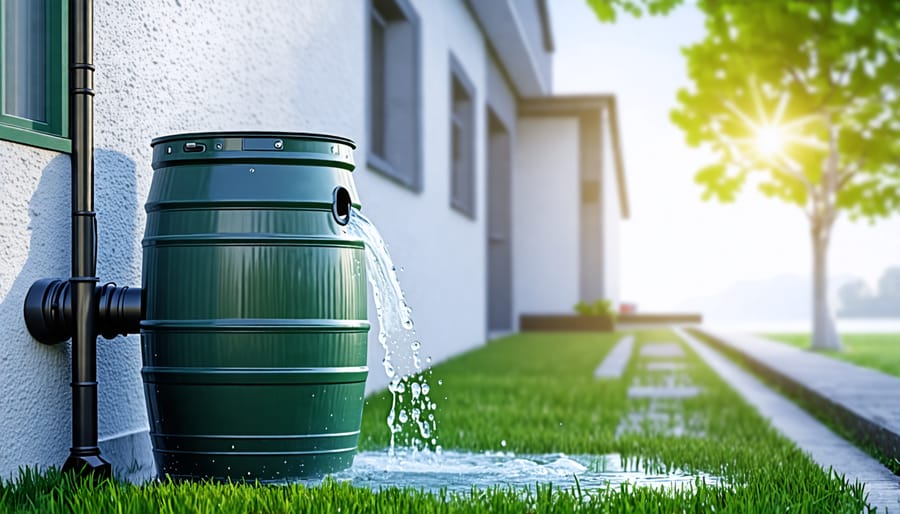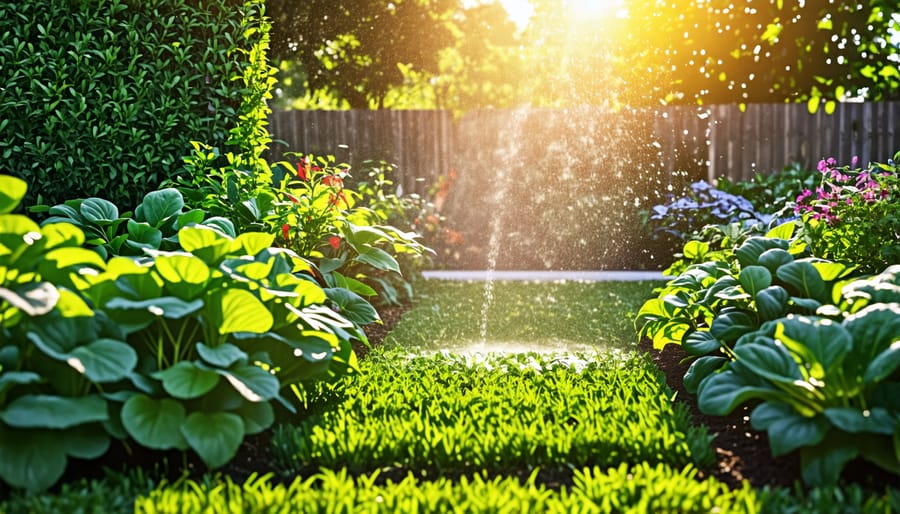
Rainwater Magic: Create a Self-Watering Garden Oasis
Harness nature’s abundance to create a thriving, self-sustaining garden oasis with rainwater irrigation. By capturing and redirecting precious rainfall, you can nourish your plants, reduce water consumption, and cultivate a lush, vibrant landscape that flourishes effortlessly. This ingenious system not only conserves a vital resource but also promotes healthier plant growth, as rainwater is free from the chemicals and additives found in tap water. Embrace the power of rainwater irrigation and unlock the full potential of your garden, creating a harmonious haven that works in tandem with the natural world. Dive into this comprehensive guide to discover how you can design, install, and maintain a rainwater garden irrigation system tailored to your unique outdoor space.
How Rainwater Irrigation Systems Work
Rainwater Collection
There are several ways to collect and store rainwater for your garden irrigation system. Rain barrels are a popular option, as they can be connected to your home’s downspouts to capture roof runoff. These barrels typically hold 50-80 gallons and have a spigot for easy access. For larger volumes, consider installing a cistern, an underground tank that can store hundreds or even thousands of gallons. Cisterns require more excavation and plumbing work but provide a significant water supply during dry spells. Another method is to create swales or berms in your landscape to direct and hold rainwater, allowing it to slowly percolate into the soil. Regardless of the collection method, it’s crucial to install proper filtration to keep debris and contaminants out of your stored water. With these systems in place, you can harness the power of free, clean rainwater to keep your garden thriving sustainably.

Distribution Network
Once the rainwater is collected in your storage tanks or barrels, it’s time to distribute it to your garden. The most efficient method is using a network of pipes, hoses, and drip lines. Start by connecting a pipe or hose from the storage tank to the garden area. If you have a larger garden, consider installing a manifold system that splits the water flow into multiple lines. This allows you to direct water to specific sections of your garden.
For targeted watering, use drip irrigation lines with emitters placed near the base of each plant. These deliver water directly to the roots, minimizing evaporation and waste. Soaker hoses are another option, which slowly release water along their length. You can also set up a timer and valve system to automate the watering schedule based on your garden’s needs.
Remember to install a filter between the storage and distribution system to prevent debris from clogging the lines. Regularly inspect and maintain your pipes, hoses, and emitters to ensure optimal performance. With a well-designed distribution network, your rainwater garden irrigation system will keep your plants thriving while conserving this precious resource.
Benefits of Rainwater Irrigation
Water Conservation
Using a rainwater garden irrigation system can significantly reduce your reliance on municipal water supplies. By collecting and storing rainwater, you minimize the need to use treated tap water for your garden. This not only conserves a precious resource but also helps lower your water bills. Rainwater is free and abundant, especially in regions with frequent rainfall. By directing this water to your garden instead of letting it go down storm drains, you’re making efficient use of a natural resource. Additionally, plants often thrive with rainwater, as it is free from chemicals and additives found in treated water.
Healthier Plants
Rainwater is the healthiest choice for your plants compared to treated tap water. It’s naturally soft, free from chemicals like chlorine and fluoride that can harm delicate foliage. Rainwater also contains beneficial micronutrients accumulated from the atmosphere, giving your plants a gentle nutrient boost with every watering. The slightly acidic pH of rainwater more closely matches what plants naturally thrive on. By irrigating with rainwater, you’ll notice your plants growing more vigorously with lush, green leaves. Collecting rainwater is like giving your garden a spa treatment – it’s the secret to achieving that stunning, effortlessly healthy look in your landscape.

Environmental Friendliness
Rainwater garden irrigation systems offer significant environmental benefits. By capturing and utilizing rainwater, these systems reduce the strain on municipal water supplies and groundwater resources. Rainwater that would otherwise flow off impermeable surfaces like roofs and driveways is collected and used to nourish plants, reducing urban runoff and preventing pollutants from entering waterways. This not only conserves water but also helps maintain the natural water cycle. Additionally, by creating a thriving garden ecosystem, rainwater irrigation supports biodiversity, providing habitats for beneficial insects, birds, and other wildlife. Embracing this eco-friendly approach to landscaping contributes to a greener, more sustainable environment.
Convenience and Low Maintenance
Once installed, rainwater garden irrigation systems automate the watering process, ensuring your plants receive the right amount of moisture without any daily effort on your part. The system collects rainwater in a storage tank and distributes it to your garden through a network of pipes and emitters. This means you can sit back and enjoy your thriving garden without constantly worrying about watering. Rainwater irrigation also requires minimal upkeep compared to traditional systems. Since rainwater is naturally soft and free from chemicals, it prevents mineral buildup in pipes and nozzles, reducing the need for frequent cleaning or replacements. With a bit of occasional monitoring and maintenance, your rainwater garden irrigation system will keep your outdoor oasis lush and beautiful for years to come.

Designing Your Rainwater Garden Irrigation System
Assessing Your Space
Before you start designing your rainwater garden irrigation system, take some time to assess your outdoor space. Consider the size of your garden and the types of plants you want to grow. Observe how water naturally flows through your yard during rainfall and identify low-lying areas where water tends to collect. These spots are ideal for creating rain gardens or bioswales. Evaluate the water needs of your existing plants and any new additions you plan to make. This will help you determine the capacity and placement of your rainwater storage containers. Take note of the proximity to your home’s downspouts, as this will influence the positioning of your collection barrels or tanks. By carefully assessing your space and understanding your garden’s unique characteristics, you’ll be well-equipped to design an efficient and effective rainwater irrigation system that meets your specific needs.
Sizing Your Rainwater Storage
To determine the ideal size for your rainwater storage tank, consider factors like your garden’s square footage, average rainfall in your area, and the water needs of your plants. As a general rule of thumb, plan for about 0.5 gallons of storage per square foot of garden space. For example, a 200 square foot garden would require a 100-gallon storage tank.
Keep in mind that rainfall varies by region, so adjust your calculations accordingly. In drier climates or during periods of drought, you may need a larger storage capacity to ensure an adequate water supply for your garden. On the other hand, if you live in an area with frequent rainfall, a smaller tank may suffice.
Additionally, consider the water requirements of your specific plants. Some species are more drought-tolerant and require less frequent watering, while others have higher water needs. Factor in these individual plant requirements when estimating your storage needs to ensure your rainwater irrigation system can keep your garden thriving.
Choosing the Right Components
When it comes to choosing the right components for your rainwater garden irrigation system, there are a few key things to consider. First, select a rain barrel that is appropriately sized for your garden’s needs and the amount of rainfall in your area. Look for barrels made of durable, food-grade materials that won’t leach chemicals into your water supply.
Next, think about the type of piping you’ll use to distribute the water from your barrel to your garden. PVC pipes are a popular choice for their affordability and ease of installation, but you may also consider more eco-friendly options like high-density polyethylene (HDPE) or copper pipes.
When selecting suitable pumps, opt for ones with enough power to efficiently move water through your irrigation system without consuming too much energy. Submersible pumps are ideal for most rainwater garden setups, as they can be placed directly inside the rain barrel.
Finally, choose high-quality, adjustable drip emitters or sprinklers to ensure even water distribution throughout your garden beds. By investing in durable, efficient components from the start, you’ll be setting your rainwater garden up for long-term success while minimizing maintenance and replacement costs down the line.
Installing and Maintaining Your System
Step-by-Step Installation Guide
Here’s a step-by-step guide to install your rainwater garden irrigation system:
1. Choose a location for your rain barrel or cistern, preferably near a downspout. Level the ground and create a sturdy base with pavers or gravel.
2. Cut the downspout to the desired height above your barrel, allowing space for the diverter and overflow pipe. Attach the diverter according to the manufacturer’s instructions.
3. Connect the overflow pipe to the diverter, directing excess water away from your foundation. Secure the pipe to the barrel with a bulkhead fitting or rubber seal.
4. Install a spigot or valve near the bottom of your barrel for a hose connection. If using a pump, follow the manufacturer’s guidelines for installation and power supply.
5. Measure and dig trenches for your irrigation pipes, burying them at least 6 inches deep to prevent damage. Lay the pipes in the trenches, connecting them to the water source and the garden beds.
6. Install a filter or screen at the barrel’s outlet to prevent debris from clogging the pipes. Regular cleaning will keep your system running smoothly.
7. Add emitters, drip lines, or sprinklers in your garden beds, adjusting their placement and flow rate based on your plants’ needs. Test the system and check for leaks or clogs.
8. Cover the trenches and mulch around the pipes to protect them and retain moisture. Your rainwater garden irrigation system is now ready to nourish your beautiful landscape!
Maintenance Tips
To keep your rainwater garden irrigation system functioning at its best, regular maintenance is key. Start by cleaning gutters and downspouts to ensure a steady flow of clean water into your storage tank. Periodically check for leaks or clogs in the pipes and repair them promptly to avoid wasting precious rainwater. Clean the pump and filter according to the manufacturer’s instructions to prevent debris buildup and maintain optimal performance. Inspect the emitters and drip lines for any signs of damage or blockage, and replace them if needed. Lastly, monitor your plants’ health and adjust the watering schedule as necessary to avoid over or under-watering. With these simple maintenance practices, your rainwater garden irrigation system will continue to thrive and conserve water for years to come.
Conclusion
By harnessing the power of rainwater, you can create a thriving and sustainable garden irrigation system that not only nourishes your plants but also conserves precious water resources. The benefits of a rainwater garden irrigation system are numerous, from reducing your water bills to promoting healthy plant growth and minimizing your environmental impact. By following the key steps outlined in this article, you can easily design, install, and maintain your own rainwater garden irrigation system. Whether you’re a seasoned gardener or just starting out, this eco-friendly solution is accessible to everyone. So why not give it a try and experience the satisfaction of nurturing your garden with the natural gift of rainwater? Embrace the simplicity and effectiveness of rainwater harvesting and watch your garden flourish like never before.
